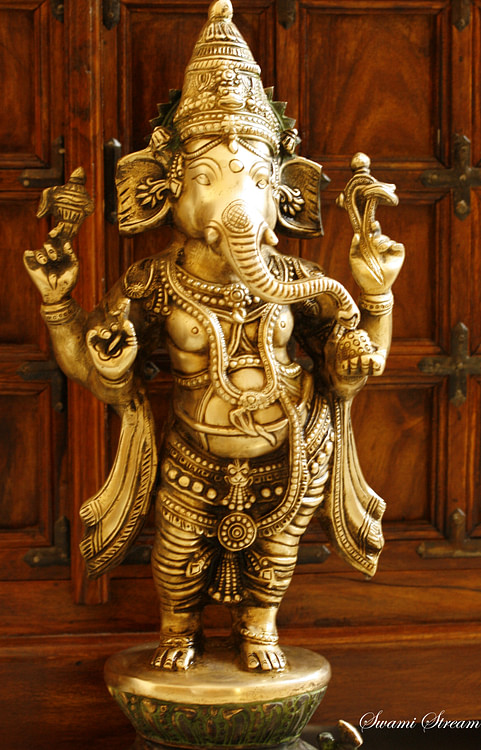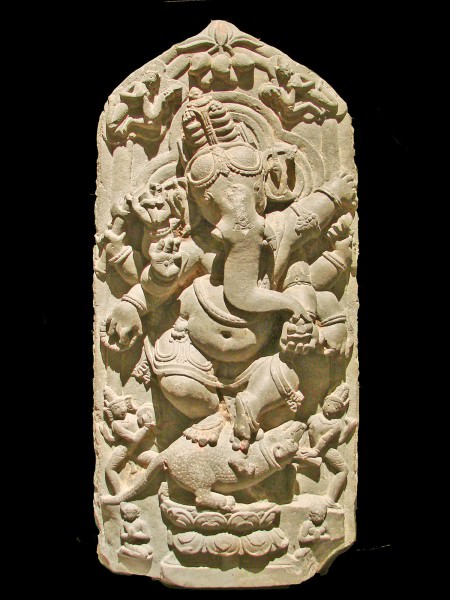Ganesha › Stupa » Ancient origins
Articles and Definitions › Contents
- Ganesha › Who Was
- Stupa › Antique Origins
Ancient civilizations › Historical and archaeological sites
Ganesha › Who Was
Definition and Origins

Ganesha (also known as Ganesa or Ganapati) is one of the most important gods in Hindu mythology and he is also worshipped in Jainism and Buddhism. For the Ganapatya Hindu sect, Ganesha is the most important deity. Ganesha is highly recognisable with his elephant head and human body, representing the soul ( atman ) and the physical ( maya ) respectively. He is also the patron of writers, travellers, students, commerce, and new projects (for which he removes obstacles from one's path) and is rather fond of sweets, to the slight detriment of his figure.
EARLY LIFE
Ganesha is the son of Shiva and Parvati and he is the brother of Karthikeya (or Subrahmanya), the god of war. He was created by his mother using earth which she moulded into the shape of a boy. As Shiva was away on his meditative wanderings, Parvati set her new son as guard while she bathed. Unexpectedly, Shiva returned home and, on finding the boy, and outraged at his impudence in claiming he was Parvati's son, Shiva called for his gang of demons, the bhutaganas, who fought ferociously with the boy. However, the youngster easily held his own against such fearsome adversaries and Vishnuwas forced to intervene in the form of Maya and, whilst the boy was distracted by her beauty, the demons, or Shiva himself, lopped off his head. At the commotion, Parvati ran from her bath and remonstrated with Shiva for so summarily killing their son. Repentant, Shiva ordered a new head to be found for the boy and, as the first animal available was an elephant, so Ganesha gained a new head and became the most distinctive of the Hindu gods. As a reward for his great courage in fighting the demons, Shiva made Ganesha the leader of the bhutaganas, hence his name.
GANESHA IS ASSOCIATED WITH WISDOM, WRITING, TRAVEL, & COMMERCE.
GANESHA'S ADVENTURES
A story which explains the god's association with intelligence and wisdom is his competition with Karthikeya to be the first to marry. They set up a challenge that whoever could first encircle the Earth would also find a bride first. Not wasting a second, Karthikeya swiftly mounted his blue peacock and immediately shot off around the world. Ganesha on the other hand, casually sauntered over to his parents' house, embraced them and quoted the line from the sacred Vedas : “he who embraces his parents seven times ( pradakshinas ) gains the merit of encircling the world seven times”. Declared the winner, Ganesha promptly married not one but two daughters of Prajapati: Buddhi (Wisdom) and Siddhi (Success), with whom he had two sons: Kshema and Laabha.
Ganesha also has something of a reputation for greediness. One day, after eating a few too many modakas (sacrificial cakes), Ganesha decided to take a ride on his giant rat, Kroncha, to aid his digestion. However, the rat was surprised when he came across a large snake and, jumping back with fear, he threw off his mount. Ganesha landed on his full belly and it burst on hitting the ground. The cakes from his stomach rolled left, right and centre but Ganesha, unperturbed, carefully gathered them in, stuffed them all back into his belly and wound the snake around his midriff to keep it closed. Symbolic of Ganesha's ability to overcome all obstacles, the snake, the cause of the accident in the first place, therefore provided the remedy for the damage it had caused.

Ganesha
Continuing on his night-ride, Ganesha suddenly heard a thunderous noise from the heavens. This was the laughing of the Moon and his wives, the twenty seven Constellations, unable to contain themselves on seeing Ganesha wrapped in a snake.Outraged, Ganesha broke off the end of one of his tusks and hurled it at the laughing Moon who, hit full in the face, was struck black. Without the light of the moon, the dark nights became the haunt of thieves and villains until honest people had had enough and pleaded with the gods to restore the silver light. The gods asked Ganesha to forgive the Moon but only a partial forgiveness was given. Consequently, only periodically, on one night, would the Moon give his full light and then he would slowly waste away.
An alternative explanation of Ganesha's broken tusk is that of Krishna throwing his axe at Ganesha after he blocked his entrance to the private apartments of his parents Shiva and Parvati. Ganesha allowed the axe to hit and break his tusk so that no-one could say that the axe, which was in fact his father's, was not a fearsome weapon. Yet another but less picturesque explanation of Ganesha's broken tusk was that he snapped it off in order to transcribe the epic poem Mahabharata, dictated by the sage Vyasa who wished to preserve the story for all time. This version explains Ganesha's association with writers and intellectuals.
REPRESENTATION IN ART
In Hindu art Ganesha is variously portrayed depending on specific cultures - Indian, Cambodian, Javanese etc. but he is most often depicted with the head of an elephant and a rather portly human body. In his hands he often carries a broken tusk, an axe, a ladle, a noose, prayer beads and a tray of sweets. He sometimes also wields an elephant goad in order to master life's obstacles. Ganesha is often depicted riding Kroncha, his giant rat, famed for its agility and also symbolic of the god's ability to circumvent obstacles.
Stupa › Antique Origins
Definition and Origins

The stupa, an architectural structure usually housing the cremated remains or possessions of important saintly figures, is considered to be the structural emblem and the most important type of monument of Buddhism. Most stupas have a very distinctive semi-spherical shape, often surrounded by a fence. As Buddhism was introduced in different regions, the basic architectural features of stupas were transformed into a variety of shapes reflecting the artistic expressions of those cultures.
ORIGIN OF THE STUPA IN THE BUDDHIST TRADITION
The Mahaparinirvana Sutra (an ancient Buddhist text describing the last days of the Buddha ) claims that after the Buddha passed away, his followers divided his cremated remains into eight portions. Each of the eight kingdoms in which the Buddha had lived received one portion of the relics, and a stupa was erected in each kingdom in order to house the remains. Buddhist sources claim that during the 3rd century BCE, the Mauryan Emperor Ashoka the Great ordered these eight stupas to be opened, further distributed the relics of the Buddha into 84,000 portions, and had stupas built over them all over the expanding Buddhist world.
STUPAS WERE CONSIDERED THE LIVING PRESENCE OF THE BUDDHA, HIS PROTECTIVE POWERS, AND HIS LIVING ENERGY.
The relics of the Buddha were not merely considered a commemorative symbol by the Buddhist community; they were believed to be the living presence of the Buddha, a depository of his protective powers and living energy. Early in the Buddhist tradition, clergy and laity alike practiced the veneration of stupas and the relics in them in order to gain spiritual merit. The importance of the stupas gradually increased as a result of both the emphasis of the Buddhist relic-cult and their multiplication during the time of Ashoka. Stupas became a symbol not only of Buddhism itself but also an architectural testimony to its expansion and strength.
It should be noted that the veneration of stupas is not unique to Buddhism. This practice had its origin in Indian traditions pre-dating the emergence of Buddhism. From pre-historical times, burial mounds containing the remains of the dead were a common funerary practice in some Indian societies: in these mounds, the living paid homage to their dead, just like Buddhists would do for their saints centuries later.
STUPAS & EARLY BUDDHISM
The earliest archaeological evidence for the presence of stupas in North India dates to the late 4th century BCE. These are all pilgrimage stupas, which means that they were built outside the domains of monastic complexes, at pilgrimage sites. Although we have no material evidence of earlier stupas, Buddhist scriptures claim that stupas were built at least a century earlier. It is possible that before this time, stupas were built with non-durable materials such as wood, or even as burial mounds, in which case archaeological detection would be nearly impossible.
The earliest evidence of monastic stupas dates back to the 2nd century BCE. These are stupas that were built within Buddhist monastic complexes. It is possible that these stupas replaced older stupas made of wood: some of their architectural components were shaped imitating wooden parts. Unfortunately none of these left any visible trace.

The 'Great Stupa' at Sanchi
ARCHITECTURAL DEVELOPMENT OF THE STUPA
During early Buddhist times, stupas were composed of a semi-spherical dome with a parasol placed on top. The dome covered a square base with a small receptacle in the centre containing relics, while a space for circumambulation was defined around the dome. This basic format underwent changes as stupas were introduced in other cultures.
In Sri Lanka, the stupa is known as dagoba. Different shapes of domes developed in Sri Lanka, and a very unique architectural expression also developed, in which the dagoba itself was enclosed by a large dome known as vatadage, supported by columns located around the dagoba. Among the many vatadages built in Sri Lanka, there is one of particular importance named Thuparama, which supposedly houses the collarbone relic of the Buddha.
In Myanmar, the stupa, known as the zedi, also went through a number of changes. The parasol on top of the dome was elongated and resembled a cone, and the number of disks increased and their size decreased, the higher they are on the dome. The square base was also modified following a complex geometry, including different levels with terraces, and resembled the shape of a pyramid.
Pagoda is the name for stupas found in China, where they are shaped like a tower. Here, the dome was eliminated, and the emphasis is on verticality. This architectural form travelled into Korea, where it is known as Tap, and also into Japan, where it known as To.

The Great Stupa at Sanchi
THE IMPORTANCE OF STUPAS IN BUDDHISM
As the importance of the stupa grew, so it did its functions and meanings. In addition to being considered the living presence of the Buddha, his protective powers, and living energy, they were also a site of rituals and ceremonies. Their presence eventually attracted other constructions including monasteries.
The pilgrimage activity around the stupa had an important impact on the social history of Buddhism. Merchants, artisans, and monks alike enjoyed the benefits of the income generated by the activity resulting from the emblematic stupas. The religious function of the stupa was still central, but market activity and social interactions revolving around it were equally important for the communities where stupas were present.
LICENSE:
Article based on information obtained from these sources:with permission from the Website Ancient History Encyclopedia
Content is available under License Creative Commons: Attribution-NonCommercial-ShareAlike 3.0 Unported. CC-BY-NC-SA License